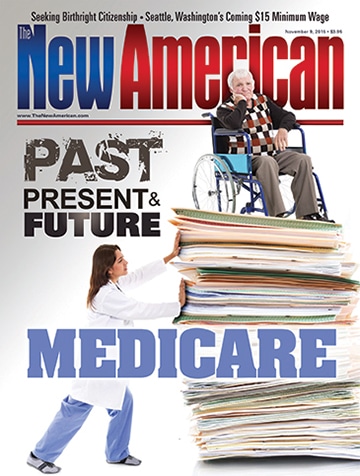How Medicare Hurts
Medicare’s Victims: How the U.S. Government’s Largest Health Care Program Harms Patients and Impairs Physicians, by David Hogberg, Washington, D.C.: The National Center for Public Policy Research, 2015, 336 pages, paperback.
The average American is likely to scoff at the title of David Hogberg’s new book, Medicare’s Victims: How the U.S. Government’s Largest Health Care Program Harms Patients and Impairs Physicians. Mainstream media outlets generally portray this 50-year experiment in socialized medicine as an unqualified success. Indeed, Hogberg reminds us, “The notion that Medicare provides good care for all of its beneficiaries has crystallized into an article of faith among many advocates of a government-run health care system who argue that we should open up Medicare to everyone.”
Hogberg, a senior fellow for healthcare policy at the National Center for Public Policy Research, begs to differ: “Medicare can’t even ensure [low-cost, high-quality care] for the people who are currently eligible for the program. Expanding it to cover all Americans would only exacerbate its shortcomings for patients.”
Medicare provides healthcare coverage for senior citizens and the disabled, most of whom — seniors especially — obtain reasonably good care despite the program’s shortcomings. The rest aren’t so lucky.
The disabled, in particular, suffer at the hands of the bureaucracy. First, they must wait two years after qualifying for Social Security Disability Insurance (SSDI) to become eligible for Medicare — a waiting period that, owing to bureaucratic delays, frequently stretches to 29 months or longer. Second, once they finally qualify for Medicare, they are likely to encounter further difficulties in paying for their healthcare needs because of the program’s high co-payments; and unlike most seniors, few have — or can afford — supplemental coverage to make up the difference. Even those willing to put up with the high cost of care under Medicare are likely to be stymied by its “goofy rules,” as one disabled man put it in an interview with Hogberg.
With low incomes, high medical expenses, and a lack of supplemental coverage, the disabled on Medicare likely have “widespread debt,” reasons Hogberg. While he admits there has been no study of Medicare-induced debt among the disabled, he writes that “there is considerable evidence” that they cannot afford healthcare, and the interviews he conducted for the book bear out this contention.
“If one of the purposes of a government health care program is protecting the sick and the poor,” Hogberg avers, “then Medicare’s treatment of the disabled fails in some substantial ways.”
Hogberg offers a quite reasonable explanation for this. Seniors are a powerful and reliable voting bloc, so Congress is highly attuned to their concerns and does its best to ensure that Medicare treats the vast majority of them well. The disabled, on the other hand, are comparatively few in number, are not easily organized, have little money or stamina to contribute to political causes, and are concerned with too many different policies to be effective.
Medicare also harms patients by subjecting them variously to either undertreatment or overtreatment, Hogberg shows.
Patients needing therapy, for example, are frequently denied coverage because the therapy isn’t making them better. Medicare will only pay for therapy that can be shown to improve a patient’s health; therapy that merely helps a patient with a degenerative disease maintain or slow the decline in his health isn’t covered.
Medicare also “doesn’t pay providers to coordinate care,” notes Hogberg, even though doing so generally helps improve patient outcomes. The program refuses to cover skilled nursing care unless a patient has previously spent at least three days as a hospital inpatient, whether those three days are needed or not. And it won’t shell out the bucks for inpatient services (such as dialysis) at a hospital unless a patient is admitted, even if admission isn’t justified because the needed service takes just a short time — a policy that proved deadly for at least one patient.
Like most other government programs, Medicare produces a great deal of waste. According to Hogberg, there are two reasons for this. First, since the patient isn’t spending his own money, he has no incentive to keep costs down. Second, because Medicare overpays for some treatments (while underpaying for others and thus causing shortages of them), doctors and hospitals are encouraged to provide those treatments more often than necessary, with sometimes devastating results, as in the case of Selma Hartmann, an 88-year-old St. Louis woman who died as a result of a botched colonoscopy that, even if it had found cancer, was unlikely to matter much at her advanced age.
The existence of this waste, meanwhile, provided the Obama administration with the cover it needed to make matters much worse for Medicare patients. ObamaCare created “accountable care organizations” (ACOs) to reward physicians for cutting costs, and the law’s “aim,” according to Hogberg, “is to put most, if not all, of the beneficiaries into ACOs,” which thus far have not proven good at either cutting costs or improving care. In addition, ObamaCare’s Independent Payment Advisory Board (IPAB), Hogberg declares, “is little more than a recipe for disaster” because it “has the power to reduce the price of Medicare services to the point that physicians and hospitals will no longer provide them.” In other words, IPAB will ration care.
Medicare’s victims also include physicians and, in turn, their patients. Doctors are increasingly refusing either to accept new Medicare patients or to take Medicare at all because they simply can’t afford to do so, partly because of the program’s low reimbursement rates and partly because of its huge administrative burden. In addition, the uncertainty of future reimbursement from the program — a matter only likely to worsen under a newly enacted formula for calculating reimbursement — and an impending change in the Medicare billing codes are also driving doctors out of the program, forcing their patients either to pay them in cash or to find another doctor.
Physician-owned specialty hospitals (PSHs) — “a major source of efficiency and innovation in the health care system,” in Hogberg’s opinion — have also fallen victim to Medicare (and ObamaCare). The “Big Hospital Lobby,” as Hogberg puts it, had for years sought to crush its smaller, more nimble competitors, but only succeeded with the passage of the Affordable Care Act, which “prevents any PSHs built after 2010 from treating Medicare patients” and erects “nearly insurmountable regulatory hurdles” to the expansion of existing PSHs. Patients will now largely be stuck with the old, lumbering, expensive, bureaucratic hospitals when they might well have preferred PSHs, and the big hospitals will be able to charge higher fees because of a lack of competition.
Hogberg correctly diagnoses Medicare’s problems: bureaucracy, political influence-peddling, wastefulness, and restriction of physician and patient choices. Unfortunately, he overlooks the fact that the program is also an unconstitutional transfer of wealth from working Americans to seniors and the disabled. Thus, he concerns himself with how to reform the program rather than how to repeal it.
Essentially, Hogberg wants Medicare to change from a system in which bureaucrats dole out money for treatments they deem necessary to one in which beneficiaries are given cash to spend on medical care, with “medical care [defined] as broadly as possible, so that beneficiaries have a lot of leeway in finding treatments that work for them.” He would give each beneficiary two accounts, one for basic care and one for major medical expenses. Both accounts would be credited with cash amounts — taken, of course, from workers’ paychecks — annually, and a portion of any balance remaining in the accounts at the end of each year would be given to the beneficiary to do with as he pleases. Hogberg believes this plan will put Medicare patients in charge of their own healthcare, thereby improving the quality of care, reducing waste, and saving taxpayers money, and he is probably right to some degree. But his proposal still leaves the federal government in charge of the program, and many of the problems plaguing traditional Medicare would no doubt creep into the new Medicare over time as interest groups and politicians sought to bend the system to their own advantage. Moreover, “Hogbergcare” would be just as unconstitutional as Medicare.
Nevertheless, Medicare’s Victims is a very worthwhile book. While it could have been dry and wonky, filled with statistics and policy prescriptions, Hogberg wisely chose to make the victims, not the numbers, the centerpiece of his book. Their stories, told to Hogberg by the victims and their families, are heartbreaking yet occasionally laced with humor. These are real people, suffering real indignities — and sometimes even death — at the hands of the coldhearted bureaucracy. (You may not want to read the book while you’re dining, though: Some of the stories are recounted in rather stomach-turning detail.)
As Hogberg demonstrates, Medicare is far from the success story that the media and politicians would have us believe it is, and it most certainly should not be extended to all Americans. Rather, it should be repealed before it claims any more victims.


